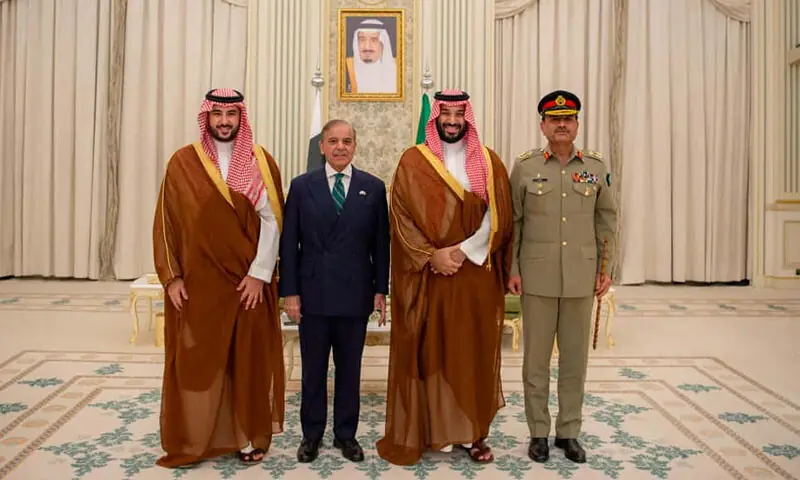Saudi Arabia-Pakistan Defence Pact: Impacts on International Politics (2025)
Strategic Implications and Geopolitical Shifts
Introduction
On September 17, 2025, Saudi Arabia and Pakistan signed a Strategic Mutual Defense Agreement (SMDA) in Riyadh, marking a formal escalation of their longstanding security partnership dating back to the 1960s. Described as a "watershed" moment by experts, the pact commits both nations to treat aggression against one as an act against both, emphasizing joint deterrence across military means. Key clauses include enhanced cooperation through joint training, technology transfers, military co-production, and potential expansions of Pakistani troop deployments in Saudi Arabia—building on historical precedents like the 50,000 Pakistani forces stationed in the kingdom during the 1980s.[1][2] The agreement reflects shared goals of regional peace amid tensions, including Israel's recent strikes on Qatar and ongoing conflicts in Gaza and Yemen.[3] This webpage examines its impacts on international politics, drawing on diverse sources for a balanced view.
Historical Context
The Saudi-Pakistan relationship has been underpinned by Saudi financial aid (billions in loans and investments) and Pakistan's role in training Saudi forces and providing strategic depth. For Pakistan, the pact secures economic lifelines during fiscal challenges and positions Islamabad as a pan-Islamic security guarantor. For Saudi Arabia, it bolsters defenses against Iran-backed Houthis and perceived Israeli aggression, diversifying from U.S. guarantees.[4][5] The SMDA formalizes existing ties without automatic war triggers, prioritizing calibrated responses.[6]
Impacts on International Politics
The pact reshapes dynamics in the Middle East, South Asia, and globally, signaling a pivot toward non-Western alliances and raising nuclear and proliferation concerns.
Middle East Regional Stability and Deterrence Against Israel
The agreement deters Israel, which has escalated strikes (e.g., Iran in June 2025, Qatar on September 9, 2025).[1] Invoking mutual defense warns that aggression against Saudi Arabia could draw Pakistan's nuclear capabilities, altering Israel's regional calculus.[5] It addresses Gulf anxieties over U.S. unreliability, potentially inspiring pacts with UAE or Qatar and activating GCC mechanisms.[4] Risks include entangling Pakistan in Saudi-Iran rivalries, but the pact emphasizes stability.[6]
Nuclear Proliferation and Global Non-Proliferation Concerns
The pact encompasses "all military means" but doesn't explicitly extend Pakistan's nuclear umbrella to Saudi Arabia, remaining India-centric.[7] Speculation persists due to Saudi funding of Pakistan's program and Crown Prince Mohammed bin Salman's "off-the-shelf" comments, but denials prevail.[8] U.S. scrutiny may intensify, pushing Riyadh toward domestic ambitions.[9] Globally, it challenges norms without violation, potentially encouraging Turkey.[10]
South Asia and Implications for India
India monitors the pact amid border skirmishes (May 2025).[11] It emboldens Pakistan, complicating New Delhi's posture, especially with Saudi-India trade ($43 billion in 2023–24).[12] The pact disrupts Saudi balancing, prompting India to accelerate Quad and U.S. ties.[6]
U.S. Alliances and Global Power Shifts
The pact erodes U.S. deterrence, nudging Gulf states toward self-help alliances.[7] It reinforces "Islamic solidarity," boosting Pakistan's soft power while signaling a multipolar shift.[4] Hype around a "nuclear axis" risks overstatement; the pact prioritizes stability.[5]
Conclusion
The Saudi-Pakistan SMDA fortifies bilateral resilience but introduces volatilities, from nuclear ambiguities to alliance realignments. Its long-term effects depend on navigating entanglements and pressures, potentially reshaping the Middle East and South Asia.[1][2]
Sources
- Saudi Arabia, Pakistan Sign Mutual Defence Pact, Al Jazeera
- Saudi Arabia, Pakistan Sign Strategic Defence Pact, Reuters
- Saudi-Pakistan Pact: Regional Implications, BBC
- Saudi Arabia-Pakistan Relations, CFR
- Saudi-Pakistan Defence Pact Implications, Stimson Center
- Saudi-Pakistan Pact: Geopolitical Shifts, ORF
- Saudi-Pakistan Nuclear Dynamics, Belfer Center
- Saudi-Pakistan Pact: Nuclear Risks, Arms Control Association
- Saudi-Pakistan Defence Pact: Proliferation, CSIS
- Saudi-Pakistan Pact Concerns, IAEA
- Saudi-Pakistan Pact: India Concerns, The Hindu
- Saudi-Pakistan Pact: India Worries, Economic Times
- Saudi-Pakistan Pact: US Allies, Belfer Center
